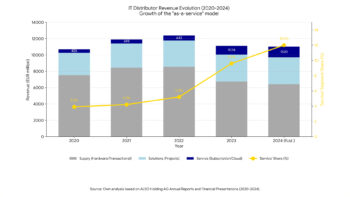The electronics distribution industry is difficult, especially due to the low-margin nature of sales. Currently, the government is considering increasing the scope of the reprographic levy, which may contribute to the crisis of Polish distribution companies due to the need to increase product prices. On the other hand, the IT industry has benefited a lot from the need for pandemic-related digitalisation. What are the characteristics of today’s electronics distribution industry? Are there still problems with equipment supply? What changes will be brought about by the introduction of the reprographic fee and how to enter this market? Janusz Rydzewski, CEO of Eoptimo, answers these questions.
What characterises today’s electronics distribution market?
Janusz Rydzewski, Eoptimo: On the market we have 3-4 large distributors – broadliners, whose aim is a large volume of sales mainly based on well-known global brands. They are the ones who generate multi-million dollar revenues, so most of their activities are focused around these brands. Smaller and less well-known producers are just an add-on for them.
We also have a number of smaller more or less specialised distributors. The market is very difficult, margins, especially with global brands, are very low. The entry threshold for new distributors is very high and without a precise strategy new companies have nothing to look for in the market.
What makes Eoptimo stand out in this market?
JR: Eoptimo is not just another distributor in the market. We are first and foremost highly specialised and our activities are focused around the area of gaming and innovation in general. Our aim is to attract smaller manufacturers with an annual turnover of several million. When smaller manufacturers want to enter the market, they often go to the largest distributors first, hoping that their wide reach will ensure them a lot of sales. This is a mistake, because for the large distributors this is just an add-on to the offer, they do not actively work with these products. These products simply get into the offer, but nothing further happens with them. The dealers focus on well-known brand products in order to make a profit in the quickest way, and they neglect products that require organic work. This does not surprise me, because this is the reality of working in a large corporation.
We are proactive, we do not sign distribution agreements just for the sake of being able to show off a wider range of products. We have a specific sales plan for each manufacturer, together with a marketing strategy for 2-3 years ahead. In this way, we give smaller producers a lot of added value compared to the big broadliners. We operate differently; we do not take on products with which we do not plan an active dynamic sales activity. We are also constantly on the lookout for interesting, innovative products that are worth introducing to the Polish market, often while the manufacturer itself is still in the prototype phase. Therefore, what sets us apart is our ability to effectively promote such products on the local market.
Our ambition is to sell very innovative, unusual and distinctive products, and we want to attract such manufacturers to us.
The consequences of the IT pandemic included delayed or non-existent hardware deliveries. What is the situation now?
JR: Unfortunately, the shortage of IT equipment on the market will be felt all the time. The consequences of the pandemic will be felt for at least another year. There is a shortage of raw materials as well as production components. In particular, we will feel shortages of consoles, especially PlayStation 5. There will be shortages of laptops and phones. The prices of these commodities have gone up and will probably go up further. The pandemic has also had some impact on the rise in the value of cryptocurrencies, resulting in increased demand for the graphics cards needed for crypto digging. Here too, shortages are sure to continue.
The IT industry is now impacting the entire economy, as IT equipment manufacturers have bought up most of the components needed for hardware production, noting an increase in demand, so that components are now in short supply in other industries, such as the automotive sector. Volkswagen has reported that the current shortage of components for production means that car production could shrink by up to 100,000 vehicles in the first quarter of 2021.
How do you assess the past year in terms of Eoptimo’s development?
JR: The past year has been marked by very dynamic growth for us. The company has almost doubled in size, we are currently growing by around 10% per month. The pandemic has been kind to us, the gaming industry has been recording regular growth and we have been riding that wave. For gaming, there has been a continuous period of prosperity for a few years. Both during the lockdown period and even now we are seeing dynamic growth in the gaming sector. Already in 2018, the gaming business was generating $118 billion, in comparison, TV revenues were $108 billion and the cinema industry was $41 billion in 2018. Analysts say the gaming industry will surpass USD 200 billion in 2023.
Our success is due in part to the industry’s rapid growth thanks to Pandemic, but the increases are primarily the result of the unique management and precise business strategy focused on the gaming industry and smaller manufacturers that I mentioned earlier.
We attract the best people in the industry because we don’t have ossified corporate structures where a person is a cog striving to get a bonus based on a strange mathematical formula. Everyone in the team knows that they can make a difference to our company with their ideas, innovative solutions, and they do. With a simple management structure, we make decisions instantly. We want the company to be associated well with everyone in the team, and these are not just slogans from a management book – this is how it really is with us. More and more people are approaching us on their own, tired of working for years in companies where nothing can be changed and where the incentive systems are demotivating. When someone new joins us, they immediately see that things are different, so people work more and more ambitiously, wanting to build a shared success.
Here we are building a team of the best in the business, people with big ambitions who really want to make a difference in the market and contribute something of their own. To use football terminology – we are building a kind of galactic Real here, like in the days of Vincente Del Bosque. We want to be the Polish Google of the distribution industry in terms of innovation and management.
What impact will the introduction of changes to the reprographics levy have on eoptimo’s business next year?
JR: Unfortunately, despite the assurances of those in power, the introduction of the reprographic levy will increase the prices of the products listed in the bill. You can read on the website of the Ministry of Culture that the levy is not a tax in the first place. For us as a company, it is yet another levy that impedes our growth regardless of how we define it and whether it goes directly to the state budget or to another institution created to redistribute these funds. The government’s argument may be convincing to the majority of the public because since the cost of producing electronic equipment is on average 30% of the value of that good on the shelf, the margin is so large that the introduction of an additional levy should not significantly reduce profits and should not affect prices. This is to say almost directly to the people that the electronics companies make a lot of money so nothing will happen if we take some away from them.
This is not true. The main problem with this kind of thinking is that the margins are actually set by the manufacturer in Asia or some other part of the world, and they will not bear the cost of such a charge directly. It is to be borne by Polish distributors and B2C sellers, and this is impossible for several reasons. The highest prevailing rate proposed by the Ministry of Culture is as much as 4 per cent of the value of the device, which is usually the distributor’s margin. Companies will not work for free or below profitability, so they will have no choice but to pass this charge on to consumers. In short – the introduction of this charge will increase the price of electronic products for consumers and that will be the only effect.
In my opinion, this is the worst time to introduce an additional charge on electronic equipment. Firstly, because a large part of the population is studying and working remotely and has had to bear the additional costs associated with this. The second aspect is that, due to the shortage of components for the production of equipment, the prices of electronics will soon reach record levels anyway, and the reprographic levy will further increase their price. Another problem is that the bill on the reprographic fee does not distinguish between the purpose for which electronic equipment is purchased, so the costs will be borne by the entire Polish business, which, after all, uses the equipment for work and not for enjoying artists’ creations.
Another doubt I have is that this fee is supposed to be compensation for copying artists’ works for personal use, which is a very archaic problem. Nowadays, in the age of YouTube, Spotify, Netflix or other services, nobody is likely to burn CDs or download MP3s of music anymore. In this respect, it is currently the best time ever for artists. With the internet at their disposal, they can reach a large audience at a very low cost, and they have a really wide range of income opportunities. The idea that the distribution industry is now supposed to pile on the extras for artists, usually giving away half or more of their profits, is very unfair. What puzzles me is the question of which artists the levy would actually go to, because when you watch the various debates on the subject in the media, the loudest in favour of the levy are artists who have been in the industry for 30-40 years, have already earned theirs, and are now looking for additional income or a way to remind themselves. Let us also add that, during the pandemic, they have already received help from the government in amounts that the rest of society or entrepreneurs could only dream of. I have my doubts that the levy will actually go to young, promising painters who lack money for paint.
Art in this day and age, if it is worthy of attention, has a really good opportunity to appear in the media. If it doesn’t exist, then maybe it’s just not good. When a private enterprise is not profitable it simply closes down and the state does not subsidise it. After all, there are many foundations, NGOs, where artists can apply and get support. With today’s opportunities provided by the media, if someone wants to break through, wants to have a reach, they have a range of opportunities to do so. This is not the 13th century, where an eminent artist starves all his or her life and after death they discover his or her talent.
Eoptimo is an innovative new company that brings great added value to the distribution market in Poland and will bring great added value to the Polish economy. We have 100% Polish capital and have managed to establish ourselves on the Polish market in a very short time, despite the very difficult industry in which we operate. It may be immodest, but I believe we have achieved success. Now this success, i.e. further development, will be stopped or very slowed down in certain areas by the additional tax. It is very depressing when a huge amount of work has been done and now it can all be lost through one ill-considered idea of those in power. I am also very sympathetic to the rest of us, especially the smaller distributors whose offerings mainly overlap with the list affected by the reprographic levy.
For Eoptimo, this will certainly result in a halt to growth in the area of goods on the list under the Act, and will also prompt us to withdraw certain products from our range or not to introduce them, such as laptops, tablets and smartphones, among others.












